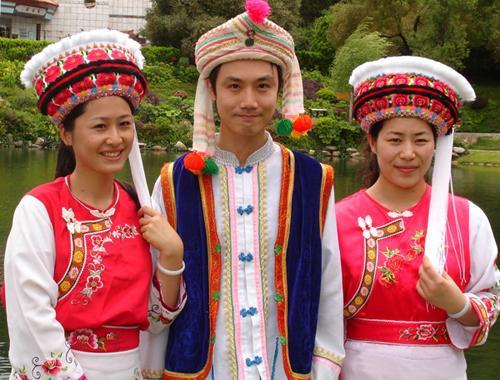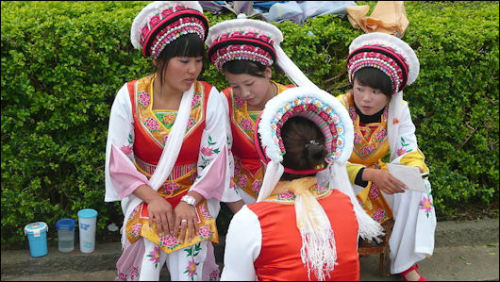The Bai or Baip (Bai language: Baipho /pɛ̰˦˨xo̰˦/ (白和 Chinese: 白族; pinyin: Báizú; endonym pronounced
The Bai or Baip (Bai language: Baipho /pɛ̰˦˨xo̰˦/ (白和 Chinese: 白族; pinyin: Báizú; endonym pronounced [pɛ̀tsī]) are an East Asian ethnic group. They constitute one of the 56 ethnic groups officially recognized by the People’s Republic of China. They numbered 1,858,063 as of 2000.The Bai people hold the colour white in high esteem and call themselves “Baipzix” (pɛ42 tsi33; Baizi 白子), “Baip'ho” (pɛ42 xo44; Baihuo 白伙), “Baip yinl” (pɛ42 ji21; Baini 白尼), or “Miep jiax”. Baip people literally means ‘white people’ in Chinese. In 1956, the Chinese authorities named them the Bai nationality according to their preference.Bai people live mostly in the provinces of Yunnan (Dali area), and in neighboring Guizhou (Bijie area) and Hunan (Sangzhi area) provinces. Of the 2 million Bai people, eighty percent live in concentrated communities in the Dali Bai Autonomous Prefecture in Yunnan Province.Although most Bai people adhere to Buddhism, they also have a native religion of Benzhuism: the worship of ngel zex (Chinese: 本主 ben zhu), local gods and ancestors. Ngel zex could be any heroes in history, the prince of the Nanzhao regime, a hero of folklore or even a tiger (for instance, Laojun Jingdi 老君景帝 is a tiger). There are minorities practicing Taoism and Christianity.There are a few villages in Yunnan where residents are Muslims, but speak Bai as their first language. These people are officially classified by Chinese authorities as belonging to the Hui nationality and call themselves Bai Hui (“Bai-speaking Muslims”). They usually say that their ancestors were Hui people, who came to Yunnan as followers of the Mongolian army in the 14th century.The Bai people, as their name would suggest, favor white clothes and decorations. Women generally wear white dresses, sleeveless jackets of red, blue or black color, embroidered belts, loose trousers, embroidered shoes of white cloth, and jewelry made of gold or silver. Women in Dali traditionally wear a white coat trimmed with a black or purple collar, loose blue trousers; embroidered shoes, silver bracelets and earrings. Unmarried women wear a single pigtail on the top of the head, while married women roll their hair. The men wear white jackets, black-collared coats, and dark loose shorts. Their headwear and costume reflect the Bai symbols: the snow, the moon, the flower, and the wind.The modern Bai are famous for their tie dyes and use them for wall hangings, table decorations, clothing, etc. -- source link
Tumblr Blog : sartorialadventure.tumblr.com
#fashion#bai#china#chinese fashion#bai fashion#bai people









